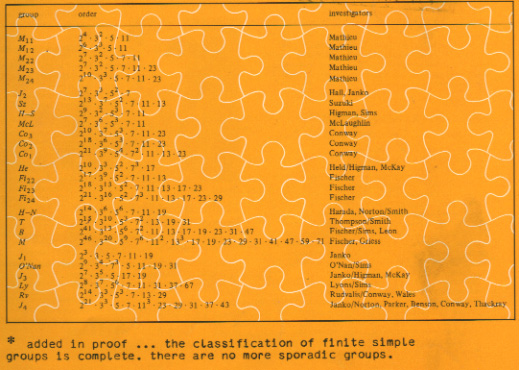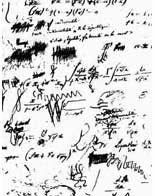Here the
story of an idea to construct new examples of non-commutative compact
manifolds, the computational difficulties one runs into and, when they
are solved, the white noise one gets. But, perhaps, someone else can
spot a gem among all gibberish…
[Qurves](http://www.neverendingbooks.org/toolkit/pdffile.php?pdf=/TheLibrary/papers/qaq.pdf) (aka quasi-free algebras, aka formally smooth
algebras) are the \’affine\’ pieces of non-commutative manifolds. Basic
examples of qurves are : semi-simple algebras (e.g. group algebras of
finite groups), [path algebras of
quivers](http://www.lns.cornell.edu/spr/2001-06/msg0033251.html) and
coordinate rings of affine smooth curves. So, let us start with an
affine smooth curve $X$ and spice it up to get a very non-commutative
qurve. First, we bring in finite groups. Let $G$ be a finite group
acting on $X$, then we can form the skew-group algebra $A = \mathbfk[X]
\bigstar G$. These are examples of prime Noetherian qurves (aka
hereditary orders). A more pompous way to phrase this is that these are
precisely the [one-dimensional smooth Deligne-Mumford
stacks](http://www.math.lsa.umich.edu/~danielch/paper/stacks.pdf).
As the 21-st century will turn out to be the time we discovered the
importance of non-Noetherian algebras, let us make a jump into the
wilderness and consider the amalgamated free algebra product $A =
(\mathbf k[X] \bigstar G) \ast_{\mathbf k G} \mathbfk H$ where $G
\subset H$ is an interesting extension of finite groups. Then, $A$ is
again a qurve on which $H$ acts in a way compatible with the $G$-action
on $X$ and $A$ is hugely non-commutative… A very basic example :
let $\mathbb{Z}/2\mathbb{Z}$ act on the affine line $\mathbfk[x]$ by
sending $x \mapsto -x$ and consider a finite [simple
group](http://mathworld.wolfram.com/SimpleGroup.html) $M$. As every
simple group has an involution, we have an embedding
$\mathbb{Z}/2\mathbb{Z} \subset M$ and can construct the qurve
$A=(\mathbfk[x] \bigstar \mathbb{Z}/2\mathbb{Z}) \ast_{\mathbfk
\mathbb{Z}/2\mathbb{Z}} \mathbfk M$ on which the simple group $M$ acts
compatible with the involution on the affine line. To study the
corresponding non-commutative manifold, that is the Abelian category
$\mathbf{rep}~A$ of all finite dimensional representations of $A$ we have
to compute the [one quiver to rule them
all](http://www.matrix.ua.ac.be/master/coursenotes/onequiver.pdf) for
$A$. Because $A$ is a qurve, all its representation varieties
$\mathbf{rep}_n~A$ are smooth affine varieties, but they may have several
connected components. The direct sum of representations turns the set of
all these components into an Abelian semigroup and the vertices of the
\’one quiver\’ correspond to the generators of this semigroup whereas
the number of arrows between two such generators is given by the
dimension of $Ext^1_A(S_i,S_j)$ where $S_i,S_j$ are simple
$A$-representations lying in the respective components. All this
may seem hard to compute but it can be reduced to the study of another
quiver, the Zariski quiver associated to $A$ which is a bipartite quiver
with on the left the \’one quiver\’ for $\mathbfk[x] \bigstar
\mathbb{Z}/2\mathbb{Z}$ which is just $\xymatrix{\vtx{}
\ar@/^/[rr] & & \vtx{} \ar@/^/[ll]} $ (where the two vertices
correspond to the two simples of $\mathbb{Z}/2\mathbb{Z}$) and on the
right the \’one quiver\’ for $\mathbf k M$ (which just consists of as
many verticers as there are simple representations for $M$) and where
the number of arrows from a left- to a right-vertex is the number of
$\mathbb{Z}/2\mathbb{Z}$-morphisms between the respective simples. To
make matters even more concrete, let us consider the easiest example
when $M = A_5$ the alternating group on $5$ letters. The corresponding
Zariski quiver then turns out to be $\xymatrix{& & \vtx{1} \\\
\vtx{}\ar[urr] \ar@{=>}[rr] \ar@3[drr] \ar[ddrr] \ar[dddrr] \ar@/^/[dd]
& & \vtx{4} \\\ & & \vtx{5} \\\ \vtx{} \ar@{=>}[uurr] \ar@{=>}[urr]
\ar@{=>}[rr] \ar@{=>}[drr] \ar@/^/[uu] & & \vtx{3} \\\ & &
\vtx{3}} $ The Euler-form of this quiver can then be used to
calculate the dimensions of the EXt-spaces giving the number of arrows
in the \’one quiver\’ for $A$. To find the vertices, that is, the
generators of the component semigroup we have to find the minimal
integral solutions to the pair of equations saying that the number of
simple $\mathbb{Z}/2\mathbb{Z}$ components based on the left-vertices is
equal to that one the right-vertices. In this case it is easy to see
that there are as many generators as simple $M$ representations. For
$A_5$ they correspond to the dimension vectors (for the Zariski quiver
having the first two components on the left) $\begin{cases}
(1,2,0,0,0,0,1) \\ (1,2,0,0,0,1,0) \\ (3,2,0,0,1,0,0) \\
(2,2,0,1,0,0,0) \\ (1,0,1,0,0,0,0) \end{cases}$ We now have all
info to determine the \’one quiver\’ for $A$ and one would expect a nice
result. Instead one obtains a complete graph on all vertices with plenty
of arrows. More precisely one obtains as the one quiver for $A_5$
$\xymatrix{& & \vtx{} \ar@{=}[dll] \ar@{=}[dddl] \ar@{=}[dddr]
\ar@{=}[drr] & & \\\ \vtx{} \ar@(ul,dl)|{4} \ar@{=}[rrrr]|{6}
\ar@{=}[ddrrr]|{8} \ar@{=}[ddr]|{4} & & & & \vtx{} \ar@(ur,dr)|{8}
\ar@{=}[ddlll]|{6} \ar@{=}[ddl]|{10} \\\ & & & & & \\\ & \vtx{}
\ar@(dr,dl)|{4} \ar@{=}[rr]|{8} & & \vtx{} \ar@(dr,dl)|{11} & } $
with the number of arrows (in each direction) indicated. Not very
illuminating, I find. Still, as the one quiver is symmetric it follows
that all quotient varieties $\mathbf{iss}_n~A$ have a local Poisson
structure. Clearly, the above method can be generalized easily and all
examples I did compute so far have this \’nearly complete graph\’
feature. One might hope that if one would start with very special
curves and groups, one might obtain something more interesting. Another
time I\’ll tell what I got starting from Klein\’s quartic (on which the
simple group $PSL_2(\mathbb{F}_7)$ acts) when the situation was sexed-up
to the sporadic simple Mathieu group $M_{24}$ (of which
$PSL_2(\mathbb{F}_7)$ is a maximal subgroup).
Tag: simples

I
found an old copy (Vol 2 Number 4 1980) of the The Mathematical Intelligencer with on its front
cover the list of the 26 _known_ sporadic groups together with a
starred added in proof saying
- added in
proof … the classification of finite simple groups is complete.
there are no other sporadic groups.
(click on the left picture to see a larger scanned image). In it is a
beautiful paper by John Conway “Monsters and moonshine” on the
classification project. Along the way he describes the simplest
non-trivial simple group $A_5 $ as the icosahedral group. as well as
other interpretations as Lie groups over finite fields. He also gives a
nice introduction to representation theory and the properties of the
character table allowing to reconstruct $A_5 $ only knowing that there
must be a simple group of order 60.
A more technical account
of the classification project (sketching the main steps in precise
formulations) can be found online in the paper by Ron Solomon On finite simple
groups and their classification. In addition to the posts by John Baez mentioned
in this
post he has a few more columns on Platonic solids and their relation to Lie
algebras, continued here.
 Last time we have seen that in order to classify all
Last time we have seen that in order to classify all
non-commutative $l$-points one needs to control the finite
dimensional simple algebras having as their center a finite
dimensional field-extension of $l$. We have seen that the equivalence
classes of simple algebras with the same center $L$ form an Abelian
group, the
Brauer group. The calculation of Brauer groups
is best done using
Galois-cohomology. As an aside :
Evariste Galois was one of the more tragic figures in the history of
mathematics, he died at the age of 20 as a result of a duel. There is
a whole site the Evariste Galois archive dedicated to his
work.
But let us return to a simple algebra $T$ over the
field $L$ which we have seen to be of the form $M(k,S)$, full
matrices over a division algebra $S$. We know that the dimension of
$S$ over $L$ is a square, say $n^2$, and it can be shown that all
maximal commutative subfields of $S$ have dimension n over $L$.
In this way one can view a simple algebra as a bag containing all
sorts of degree n extensions of its center. All these maximal
subfields are also splitting fields for $S$, meaning that
if you tensor $S$ with one of them, say $M$, one obtains full nxn
matrices $M(n,M)$. Among this collection there is at least one
separable field but for a long time it was an open question
whether the collection of all maximal commutative subfields also
contains a Galois-extension of $L$. If this is the case, then
one could describe the division algebra $S$ as a crossed
product. It was known for some time that there is always a simple
algebra $S’$ equivalent to $S$ which is a crossed product (usually
corresponding to a different number n’), that is, all elements of
the Brauer group can be represented by crossed products. It came as a
surprise when S.A. Amitsur in 1972 came up with examples of
non-crossed product division algebras, that is, division algebras $D$
such that none of its maximal commutative subfields is a Galois
extension of the center. His examples were generic
division algebras $D(n)$. To define $D(n)$ take two generic
nxn matrices, that is, nxn matrices A and B such that all its
entries are algebraically independent over $L$ and consider the
$L$-subalgebra generated by A and B in the full nxn matrixring over the
field $F$ generated by all entries of A and B. Somewhat surprisingly,
one can show that this subalgebra is a domain and inverting all its
central elements (which, again, is somewhat of a surprise that
there are lots of them apart from elements of $L$, the so called
central polynomials) one obtains the division algebra $D(n)$ with
center $F(n)$ which has trancendence degree n^2 1 over $L$. By the
way, it is still unknown (apart from some low n cases) whether $F(n)$
is purely trancendental over $L$. Now, utilising the generic
nature of $D(n)$, Amitsur was able to prove that when $L=Q$, the
field of rational numbers, $D(n)$ cannot be a crossed product unless
$n=2^s p_1…p_k$ with the p_i prime numbers and s at most 2. So, for
example $D(8)$ is not a crossed product.
One can then
ask whether any division algebra $S$, of dimension n^2 over $L$, is a
crossed whenever n is squarefree. Even teh simplest case, when n is a
prime number is not known unless p=2 or 3. This shows how little we do
know about finite dimensional division algebras : nobody knows
whether a division algebra of dimension 25 contains a maximal
cyclic subfield (the main problem in deciding this type of
problems is that we know so few methods to construct division
algebras; either they are constructed quite explicitly as a crossed
product or otherwise they are constructed by some generic construction
but then it is very hard to make explicit calculations with
them).